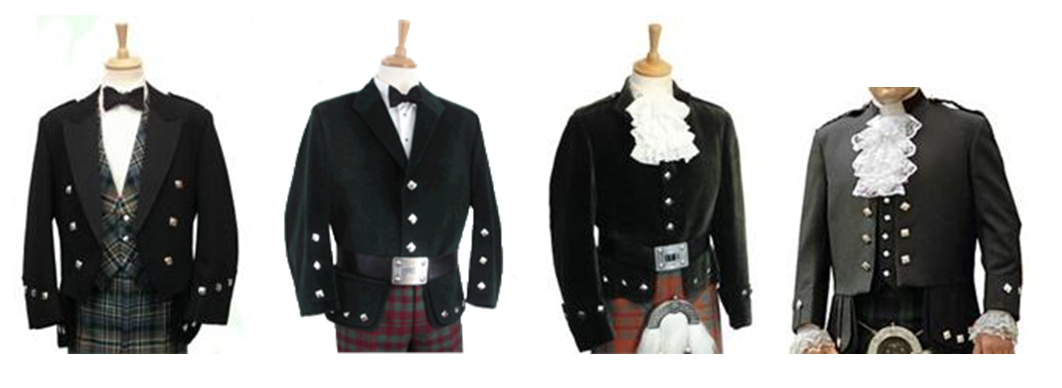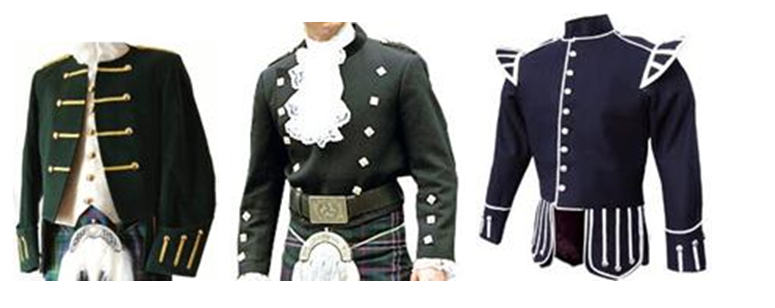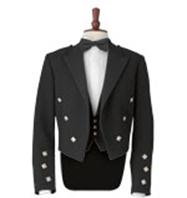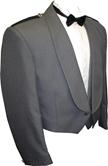| This Week’s Topic… | |

Best viewed in
|
Highland Attire The term Highland attire describes the traditional dress of Scotland. It is often characterized by tartan patterns in some form. Male highland dress includes kilt (or trews - pants), sporran, sgian dubh and ghillies. Ghillies, or ghillie brogues, are traditional thick soled shoes with no tongues and long laces. The laces are wrapped around and tied above the wearer's ankles so that the shoes do not get pulled off in mud. The shoes lack tongues so the wearer's feet can dry more quickly in typically damp Scottish weather. The ghillie brogue is named after the ghillie, the traditional Scottish gamekeeper and outdoorsman. Female highland dress includes women's shoes, also called ghillies, that are tied in the same way but have thin soles for indoor wear and dancing. Traditionally, women and girls do not wear kilts but may wear ankle-length tartan skirts. A tartan sash or shawl may also be worn. Women may also wear dress tartans which are modified versions which include white in place of a more prominent color. Let me explain some of the kilt jacket styles. The most common form of kilt jacket is the Argyle (sometimes spelled Argyll); it is the equivalent of a sport coat. It can be worn with a black bow tie for "black tie" affairs. It can also be worn equally well with a neck tie for a less formal look. It is typically worn with a five button waistcoat, but can be worn with equal flare with a three button waistcoat for more formal occasions or without for casual events. If you are to only acquire one kilt jacket to serve for both formal and semi-formal functions, the black Argyle is an excellent choice. Argyle jackets are usually available in a variety of other colors. Darker colors, such as navy blue, also lend themselves well to more dressy occasions. Argyle jackets made from lighter colored wool or tweeds are considered day wear jackets. These are more appropriate for wear at Highland Games, morning or daytime functions, etc. There are different styles of cuff to be had on an Argyle jacket, and the names of these cuffs often confuse people. In general, the gauntlet cuffs are called "Argyle," the three-button patch cuffs are called "Braemar," while plain cuffs are called "Crail." These names are not universally used by all jacket manufacturers however.
One note about wearing any type of waistcoat with the kilt. Whenever a waistcoat, sweater or pullover is worn (in other words, anything that covers the top of the kilt), there is no need to wear a kilt belt. Forgoing the belt creates a much cleaner look, and in fact can be more comfortable. A variation of the Argyle is the Doublet. There are four distinct types of highland kilt doublets: the regulation, the Balmoral, the Kenmore, and the Sheriffmuir. The regulation kilt doublet is a typically black double-breasted jacket with satin peaked lapels, buttoned gauntlet cuffs, and epaulettes. The Regulation doublet was at one time the regulation uniform jacket of the Highland regiments, and is worn with a three-button waistcoat which may be made from the same cloth as the jacket or kilt. The Balmoral kilt doublet is a double- or single-breasted jacket traditionally made from velvet. It is usually worn with a belt and black bow tie. It may be worn for both black tie and white tie events. The Kenmore kilt doublet is a single-breasted jacket, worn buttoned up (no lapels) and without a waistcoat. It is traditionally made from velvet and is always worn with a belt, lace jabot and cuffs. It may be worn on all formal occasions. The Sheriffmuir kilt doublet is a double-breasted jacket with gauntlet cuffs and a stand collar with no lapels. It is typically worn open with a waistcoat, lace jabot and cuffs.
There are also Acara, Montrose, and various styles of military doublets:
The Prince Charlie is a “Tailcoat” or “Coatee.” A tailcoat is a coat with the front of the skirt cut away, so as to leave only the rear section of the skirt, known as the tails. The historical reason coats were cut this way was to make it easier for the wearer to ride a horse, but over the years tailcoats of varying types have evolved into forms of formal dress for both day and evening wear. The Prince Charlie has a square cut away front and the tails are cut short.
The mess jacket features either a non-fastening double breast cut or a single-breasted version that fastens. The jackets have shawl or peak lapels. Used in military mess dress, during the 1930s it became a popular alternative to the white dinner jacket in hot and tropical weather for black tie occasions. It also was prominently used, in single-breasted form, as part of the uniform for underclassmen at Eton College, leading to the alternate name Eton jacket.
With that information at hand, you can now follow the following dress descriptions. Casual dress Here, just about anything goes…and does…but typically includes:
Morning dress The morning suit version of Highland dress consists of:
Black tie Traditionally, black tie Scots Highland dress comprises:
White tie The traditional white-tie version of Highland dress consists of:
|




